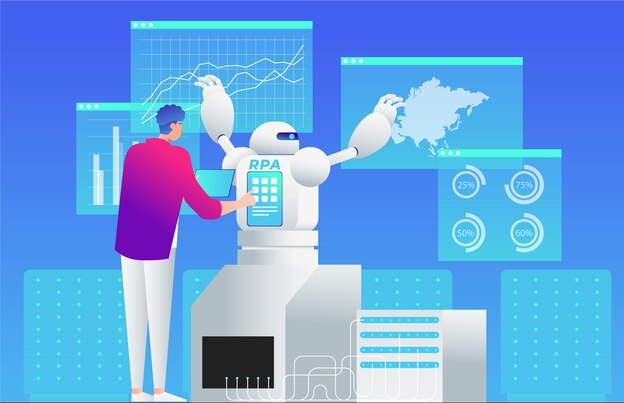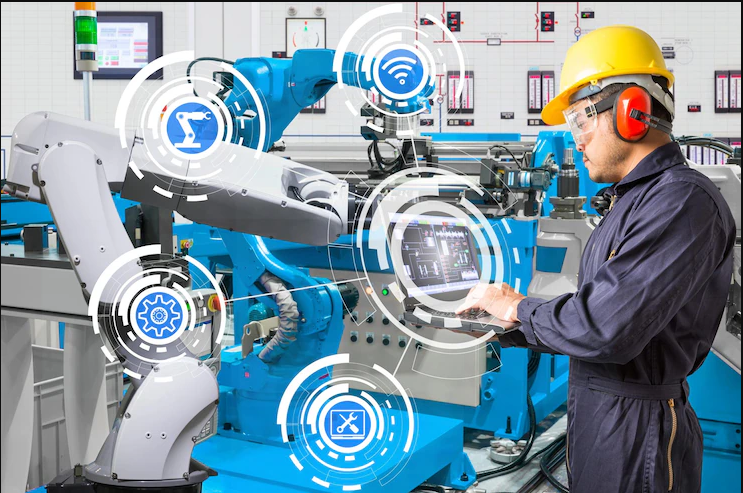One such technology making waves is Robotic Process Automation (RPA). This article explores the pivotal role of RPA in reshaping business processes and unlocking new levels of productivity.
In the dynamic landscape of modern business, organizations are increasingly turning to innovative technologies to streamline operations, enhance efficiency, and stay competitive.
Robotic Process Automation
Definition and Overview
Robotic Process Automation, often abbreviated as RPA, refers to the use of software robots or “bots” to automate repetitive, rule-based tasks within business processes. These bots mimic human interactions with digital systems, executing tasks such as data entry, invoice processing, and customer query handling with speed and precision.
Key Components of RPA
RP systems typically consist of three key components:
- Bot Creator: Allows users to design and create bots without extensive programming knowledge.
- Bot Runner: Executes the automated tasks based on predefined rules and instructions.
- Control Center: Manages and monitors the performance of deployed bots, providing insights into process efficiency.
Advantages of Implementing RPA
Enhanced Efficiency and Accuracy
One of the primary advantages of RPA is the significant improvement in process efficiency. Bots can execute tasks around the clock without breaks, resulting in faster task completion. Moreover, RP reduces the likelihood of errors often associated with manual data entry, leading to increased accuracy in business processes.
Cost Savings
By automating repetitive tasks, organizations can achieve substantial cost savings. RP eliminates the need for human intervention in routine processes, allowing employees to focus on more strategic, value-added activities. This not only increases overall productivity but also optimizes resource allocation.
Scalability and Flexibility
RPA systems are highly scalable, making them suitable for businesses of varying sizes. Whether an organization needs to automate a few tasks or entire processes, RP can adapt to different scales of operation. Additionally, RP platforms are designed to integrate seamlessly with existing systems, offering flexibility in implementation.
Improved Customer Experience
Automation through RPA can lead to faster response times and more accurate processing of customer requests. This, in turn, enhances the overall customer experience. Businesses can provide quicker resolutions to customer queries, leading to increased satisfaction and loyalty.
Use Cases of RPA Across Industries

Finance and Accounting
In the finance sector, RP is employed for tasks such as invoice processing, reconciliation, and compliance reporting. Bots can handle repetitive financial processes with precision, reducing the risk of errors and ensuring compliance with regulations.
Human Resources
RPA finds applications in human resources for automating tasks like employee onboarding, payroll processing, and benefits administration. This allows HR professionals to focus on strategic initiatives, fostering a more strategic and efficient HR function.
Healthcare
Within healthcare, RP is utilized for tasks such as claims processing, appointment scheduling, and data extraction. Automation in healthcare processes enhances accuracy, reduces administrative burden, and contributes to improved patient care.
Supply Chain Management
RPA plays a vital role in optimizing supply chain operations. It can streamline order processing, inventory management, and demand forecasting, leading to more efficient and responsive supply chain processes.
Implementing RPA
Comprehensive Process Analysis
Before implementing RPA, organizations should conduct a thorough analysis of existing processes. Identifying repetitive and rule-based tasks that are suitable for automation is crucial for successful RP implementation.
Stakeholder Involvement and Training
Involving key stakeholders from various departments ensures that the chosen processes for automation align with overall business goals. Additionally, providing training for employees who will interact with the RP system ensures a smooth transition and maximizes the benefits of automation.
Security Measures
As RPA involves handling sensitive data, implementing robust security measures is paramount. This includes encryption of data, role-based access control, and regular security audits to identify and address potential vulnerabilities.
Continuous Monitoring and Optimization
Post-implementation, continuous monitoring of RP processes is essential. Regular evaluations allow organizations to identify areas for optimization, ensuring that the automated processes remain effective and aligned with evolving business needs.
Challenges and Considerations in RPA Adoption
Initial Implementation Costs
While RPA offers long-term cost savings, the initial investment in implementation can be significant. Organizations need to carefully assess the costs and benefits to determine the feasibility of RP adoption.
Complexity of Processes
Not all processes are suitable for automation. Complex, judgment-based tasks may require human intervention. It’s crucial to identify the processes that offer the highest return on investment in terms of automation.
Integration with Existing Systems
Integrating RPA with existing IT infrastructure can be a challenge. Compatibility issues may arise, requiring careful planning and collaboration between IT teams and RP solution providers.
Future Trends and Innovations in RPA
Artificial Intelligence Integration
The integration of RP with Artificial Intelligence (AI) is an emerging trend. Combining RP’s rule-based automation with AI’s cognitive capabilities allows for more intelligent, adaptive, and context-aware automation.
Advanced Analytics and Process Mining
The use of advanced analytics and process mining in conjunction with RP enables organizations to gain deeper insights into their processes. This data-driven approach helps identify areas for further optimization and enhancement.
Cloud-Based RPA Solutions
Cloud-based RPA solutions are gaining popularity due to their scalability, accessibility, and cost-effectiveness. Organizations are increasingly adopting cloud-based RP to leverage these advantages.
Limitations of Implementing RPA in Business Processes
1. Initial Implementation Costs and ROI Concerns
While RPA promises long-term cost savings, the upfront investment in implementation can be substantial. Organizations may face challenges in justifying these costs, especially if the return on investment (ROI) is not clearly defined or takes an extended period to materialize.
2. Complexity of Processes
Not all business processes are conducive to automation. Tasks requiring complex decision-making, creativity, or subjective judgment are often beyond the capabilities of RP. Identifying the right processes for automation is critical to avoiding inefficiencies and limitations.
3. Dependency on Rule-Based Instructions
RPA operates based on predefined rules and instructions. Processes that involve unstructured data, frequent changes, or exceptions may pose challenges. RP systems may struggle to adapt to unexpected scenarios, leading to errors or the need for constant manual intervention.
4. Integration Challenges with Existing Systems
Integrating RPA with existing IT infrastructure can be complex. Compatibility issues may arise, particularly in organizations with diverse legacy systems. Seamless integration requires careful planning, collaboration between IT teams and RPA providers, and ongoing support.
Potential Drawbacks and Considerations

1. Job Displacement and Workforce Transition
The introduction of RP may lead to concerns about job displacement, especially for employees engaged in routine, rule-based tasks. Organizations must carefully manage the transition, offering reskilling opportunities and emphasizing the role of RP as a complement to human skills.
2. Limited Cognitive Abilities
RPA systems lack cognitive abilities beyond rule-based automation. Tasks requiring emotional intelligence, creativity, or nuanced decision-making are outside the scope of RP. Human intervention remains essential for addressing complex, non-routine aspects of business processes.
3. Security and Data Privacy Risks
Handling sensitive data, RPA introduces security and data privacy risks. Organizations must implement robust security measures, including encryption, access controls, and regular audits, to safeguard against potential breaches and unauthorized access to sensitive information.
4. Maintenance and Scalability Challenges
Maintaining and scaling RPA systems can pose challenges. As business processes evolve, RP configurations may require updates and adjustments. Organizations need a structured approach to maintenance and scalability to ensure the continued effectiveness of automated processes.
Conclusion
In conclusion, Robotic Process Automation (RP) is a transformative technology that plays a crucial role in modernizing business operations.
From enhancing efficiency and accuracy to enabling cost savings and scalability, the benefits of RP are substantial.
While challenges exist, careful planning, stakeholder involvement, and adherence to best practices can pave the way for successful RPA implementation.
As businesses continue to evolve, RP stands as a powerful tool for driving operational excellence and ensuring competitiveness in the ever-changing landscape of modern business.
In the context of optimizing business operations through Robotic Process Automation (RPA), having a reliable and high-speed internet connection is paramount.
Businesses looking to implement RPA seamlessly and leverage its benefits should consider robust connectivity options, and Optimum WiFi plans emerge as a noteworthy choice.
Optimum offers a range of WiFi plans designed to meet the demands of modern businesses, providing the speed and reliability required for smooth RPA processes.
With Optimum WiFi plans, organizations can ensure uninterrupted connectivity, facilitating efficient communication between RP systems and enabling the swift execution of automated tasks.
A dependable internet connection is the backbone of successful RPA implementation, and Optimum WiFi plans cater to this essential need with their performance-oriented offerings.

